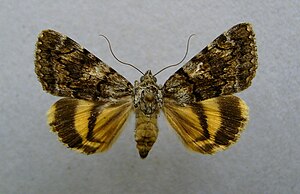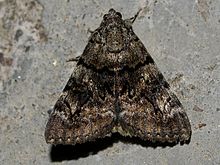Catocala nymphagoga
| Catocala nymphagoga | ||||||||||||
|---|---|---|---|---|---|---|---|---|---|---|---|---|

Catocala nymphagoga |
||||||||||||
| Systematics | ||||||||||||
|
||||||||||||
| Scientific name | ||||||||||||
| Catocala nymphagoga | ||||||||||||
| ( Esper , 1787) |
Catocala nymphagoga is a butterfly ( moth ) from the family of the owl butterflies (Noctuidae).
features
butterfly
The wingspan of the moth is 28 to 44 millimeters. The upper side of the forewing shows different shades of brown. The outer transverse line is narrow, black-brown and strongly jagged, the inner broad and almost straight. Blemishes only stand out indistinctly. The upper side of the hind wing has a yellow color, a wide, black-brown outer and a narrow, slightly curved central band of the same color. The middle band is strongly kinked at the end. A small yellow field can be seen near the apex . Occasionally there are specimens with almost black hind wings or creamy white forewings. The thorax and abdomen are brownish.
egg
The spherical egg is bright reddish yellow in color and has a strongly flattened base. It is covered with strong, straight longitudinal ribs, half of which reach the micropyl zone .
Caterpillar, pupa
The caterpillars are gray to brown in color. When fully grown, they are 40 to 45 millimeters long. Small red-brown spots are distributed over the entire surface of the body. They also show reddish-colored, hump-like elevations on the eighth and eleventh segments. The skin fringes on the sides are strongly developed. The red-brown pupa has bluish white frosting.
Similar species
- The similar species Catocala brandti differs from Catocala nymphagoga by the slightly more pronounced markings on the upper side of the forewing, the black-brown inner middle band on the upper side of the hind wing with less kinking at the end and the greenish or yellowish color of the thorax and abdomen. A genital morphological examination is recommended for reliable differentiation .
- Catocala disjuncta and Catocala diversa differ in the clear blemishes on the upper side of the forewing.
distribution and habitat
Catocala nymphagoga is widespread in southern and southeastern Europe and is also native to the islands of Corsica , Sardinia , Sicily , Malta and Crete . It is also found in North Africa and Asia Minor. The species is not indigenous in Central Europe and occurs only very rarely as a migrant butterfly in Switzerland and Austria . Individual specimens have also been found in the British Isles and Belgium .
The species primarily inhabits holm oak bush forests, downy oak forests and other light, warm and dry oak forests.
Way of life
The moths are mainly found between July and September. You visit artificial light sources and baits . The caterpillars live from April to June and feed on the leaves of various oak species ( Quercus ). The species overwinters as an egg.
swell
Individual evidence
- ↑ a b c Barry Goater, László Ronkay, Michael Fibiger: Catocalinae & Plusiinae. Noctuidae Europaeae, Volume 10., Sorø, 2003, ISBN 87-89430-08-5 , pp. 91-93
- ^ A b Walter Forster , Theodor A. Wohlfahrt : The butterflies of Central Europe. Volume 4: Owls. (Noctuidae). Franckh'sche Verlagshandlung, Stuttgart 1971, ISBN 3-440-03752-5 , pp. 284-285.
- ↑ Catocala nymphagoga from the Lienz Dolomites
- ↑ UKmoths
- ↑ 'klein geel weeskind' in Belgium
literature
- Barry Goater, László Ronkay, Michael Fibiger: Catocalinae & Plusiinae. Noctuidae Europaeae, Volume 10., Sorø, 2003, ISBN 87-89430-08-5 , pp. 91-93
Web links
- Lepiforum e. V. - Taxonomy and photos
- Moths and Butterflies of Europe and North Africa - Imago and caterpillar
- pyrgus.de - Butterflies and their ecology
- funet.fi - dissemination
- Catocala nymphagoga in Fauna Europaea. Retrieved January 13, 2017
